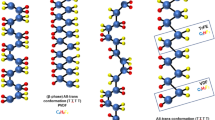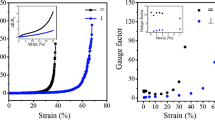Abstract
Alloying technique as an ancient and practical instrument has been a diverse fabricator for desirable properties of materials. Herein, utilizing the alloying engineering, we have developed a two-step process for hybrid graphene-NiW nanofibers (Gr-NiW NFs) transparent electrodes. Further analysis reveals that alloying NiW NFs significantly improve their mechanical performance, reducing the growth temperature of graphene down to ~ 700 °C or below, which is far less than that of ~ 1000 °C for graphene grown on Cu or Pt. More importantly, such Gr-NiW network has exhibited excellent transmittance in a broad wavelength and remarkable conductivity, which, in turn, could be tailored by the growth temperature and the W content. A high transmittance (84.2% at 550 nm) and low sheet resistance (125.4 Ohm/square) were observed at Ni NFs with 5 wt% W. The combination of excellent conductivity, high transparency and mechanical tunability makes it a promising candidate for wearable electronics and optoelectronics. Finally, an all-nanofiber-based pressure sensor on sandwiched Gr-NiW/P(VDF-TrFE)/Gr-NiW NFs was demonstrated, with high sensitivity (0.61 mV kPa−1) and excellent operation stability. This work offers deep insights into the development of transparent graphene-based electrodes via alloy engineering.





Similar content being viewed by others
References
Kou H, Lu J, Li Y (2014) High-strength and high-ductility nanostructured and amorphous metallic materials. Adv Mater 26:5518–5524
Wu H, Fan G (2020) An overview of tailoring strain delocalization for strength-ductility synergy. Prog Mater Sci 113:100675
George EP, Raabe D, Ritchie RO (2019) High-entropy alloys. Nat Rev Mater 4:515–534
Li Z, Zhao S, Ritchie RO, Meyers MA (2019) Mechanical properties of high-entropy alloys with emphasis on face-centered cubic alloys. Prog Mater Sci 102:296–345
Papageorgiou DG, Kinloch IA, Young RJ (2017) Mechanical properties of graphene and graphene-based nanocomposites. Prog Mater Sci 90:75–127
Castro Neto AH, Guinea F, Peres NMR et al (2009) The electronic properties of graphene. Rev Mod Phys 81:109–162
Nair RR, Blake P, Grigorenko AN et al (2008) Fine structure constant defines visual transparency of graphene. Science 320:1308–1308
Deng B, Liu Z, Peng H (2019) Toward mass production of CVD graphene films. Adv Mater 31:1800996
Zhu MM, Wu J, Du ZH et al (2015) A wafer-scale graphene and ferroelectric multilayer for flexible and fast-switched modulation applications. Nanoscale 7:14730–14737
**ao D, Zhu M, Wang Q et al (2020) A flexible and ultra-broadband terahertz wave absorber based on graphene–vertically aligned carbon nanotube hybrids. J Mater Chem C 8:7244–7252
Li X, Cai W, An J et al (2009) Large-area synthesis of high-quality and uniform graphene films on copper foils. Science 324:1312–1314
Wu T, Zhang X, Yuan Q et al (2016) Fast growth of inch-sized single-crystalline graphene from a controlled single nucleus on Cu–Ni alloys. Nat Mater 15:43–47
Huang M, Bakharev PV, Wang Z-J et al (2020) Large-area single-crystal AB-bilayer and ABA-trilayer graphene grown on a Cu/Ni(111) foil. Nat Nanotechnol 15:289–295
Gao L, Ren W, Xu H et al (2012) Repeated growth and bubbling transfer of graphene with millimetre-size single-crystal grains using platinum. Nat Commun 3:699
Zhang B, Chen B, Wu J et al (2017) The electrochemical response of single crystalline copper nanowires to atmospheric air and aqueous solution. Small 13:1603411
Li X, Lu K (2017) Playing with defects in metals. Nat Mater 16:700–701
Morishita M, Koyama K, Yagi S, Zhang G (2001) Calculated phase diagram of the Ni–Mo–B ternary system. J Alloys Compd 314:212–218
Zhu MM, Wu J, Du ZH et al (2018) Gate voltage and temperature dependent Ti-graphene junction resistance toward straightforward p-n junction formation. J Appl Phys 124:215302
Li D, **a Y (2004) Electrospinning of nanofibers: Reinventing the wheel? Adv Mater 16:1151–1170
Xue J, Wu T, Dai Y, **a Y (2019) Electrospinning and electrospun nanofibers: methods, materials, and applications. Chem Rev 119:5298–5415
Ico G, Showalter A, Bosze W et al (2016) Size-dependent piezoelectric and mechanical properties of electrospun P(VDF-TrFE) nanofibers for enhanced energy harvesting. J Mater Chem A 4:2293–2304
Li R, Rao L, Zhang J et al (2021) Novel in-situ electroflotation driven by hydrogen evolution reaction (HER) with polypyrrole (PPy)-Ni-modified fabric membrane for efficient oil/water separation. J Memb Sci 635:119502
You X, Zhang J, Shen L et al (2021) Thermodynamic mechanisms of membrane fouling during filtration of alginate solution in coagulation-ultrafiltration (UF) process in presence of different ionic strength and iron(III) ion concentration. J Memb Sci 635:119532
Wu J, **a M, Li Z et al (2021) Facile preparation of polyvinylidene fluoride substrate supported thin film composite polyamide nanofiltration: effect of substrate pore size. J Memb Sci 638:119699
Tay RY, Park HJ, Lin J et al (2018) Concentric and spiral few-layer graphene: growth driven by interfacial nucleation vs screw dislocation. Chem Mater 30:6858–6866
Zhu MM, Du ZH, Yin ZY et al (2016) Low-temperature in situ growth of graphene on metallic substrates and its application in anticorrosion. ACS Appl Mater Interfaces 8:502–510
Lander JJ, Kern HE, Beach AL (1952) Solubility and diffusion coefficient of carbon in nickel: reaction rates of nickel-carbon alloys with barium oxide. J Appl Phys 23:1305–1309
Hu X, Hemmat Z, Majidi L et al (2020) Controlling nanoscale thermal expansion of monolayer transition metal dichalcogenides by alloy engineering. Small 16:1905892
Hu L, Kim HS, Lee J et al (2010) Scalable coating and properties of transparent, flexible, silver nanowire electrodes. ACS Nano 4:2955–2963
Gruner G, Angeles L, Gong J et al (2007) Electrowetting devices with transparent single-walled carbon nanotube electrodes Electrowetting devices with transparent single-walled carbon nanotube electrodes. Appl Phys Lett 90:093124
Zhu Y, Lu W, Sun Z et al (2011) High throughput preparation of large area transparent electrodes using non-functionalized graphene nanoribbons. Chem Mater 23:935–939
Sa K, Mahanandia P (2019) Conducting reduced graphene oxide film as transparent electrode. Thin Solid Films 692:137594
Kim KS, Zhao Y, Jang H et al (2009) Large-scale pattern growth of graphene films for stretchable transparent electrodes. Nature 457:706–710
Kholmanov IN, Magnuson CW, Piner R et al (2015) Optical, electrical, and electromechanical properties of hybrid graphene/carbon nanotube films. Adv Mater 27:3053–3059
Yousry YM, Yao K, Mohamed AM et al (2020) Theoretical model and outstanding performance from constructive piezoelectric and triboelectric mechanism in electrospun PVDF fiber film. Adv Funct Mater 30:1910592
Surmenev RA, Orlova T, Chernozem RV et al (2019) Hybrid lead-free polymer-based nanocomposites with improved piezoelectric response for biomedical energy-harvesting applications: a review. Nano Energy 62:475–506
Zhu MM, Chng SS, Cai WF et al (2020) Piezoelectric polymer nanofibers for pressure sensors and their applications in human activity monitoring. RSC Adv 10:21887–21894
Persano L, Dagdeviren C, Su Y et al (2013) High performance piezoelectric devices based on aligned arrays of nanofibers of poly(vinylidenefluoride-co-trifluoroethylene). Nat Commun 4:1633
Peng X, Dong K, Ye C et al (2020) A breathable, biodegradable, antibacterial, and self-powered electronic skin based on all-nanofiber triboelectric nanogenerators. Sci Adv 6:eaba9624
Acknowledgements
The authors sincerely acknowledge Dr. Weifan Cai and Dr. Zehui Du for their help in sensor testing and discussion.
Author information
Authors and Affiliations
Corresponding authors
Ethics declarations
Conflict of interest
The authors declare no conflict of interest.
Additional information
Handling Editor: Catalin Croitoru.
Publisher's Note
Springer Nature remains neutral with regard to jurisdictional claims in published maps and institutional affiliations.
Rights and permissions
About this article
Cite this article
Zhu, M., Zhao, A., Wei, C. et al. Hybrid graphene-NiW nanofiber transparent electrodes for all-nanofiber-based pressure sensor. J Mater Sci 57, 2627–2635 (2022). https://doi.org/10.1007/s10853-021-06702-7
Received:
Accepted:
Published:
Issue Date:
DOI: https://doi.org/10.1007/s10853-021-06702-7




